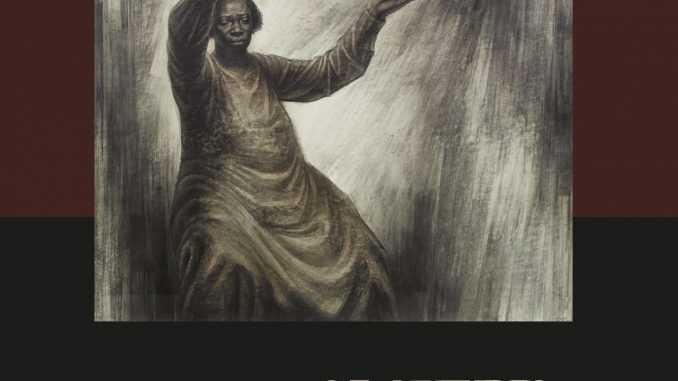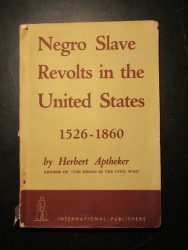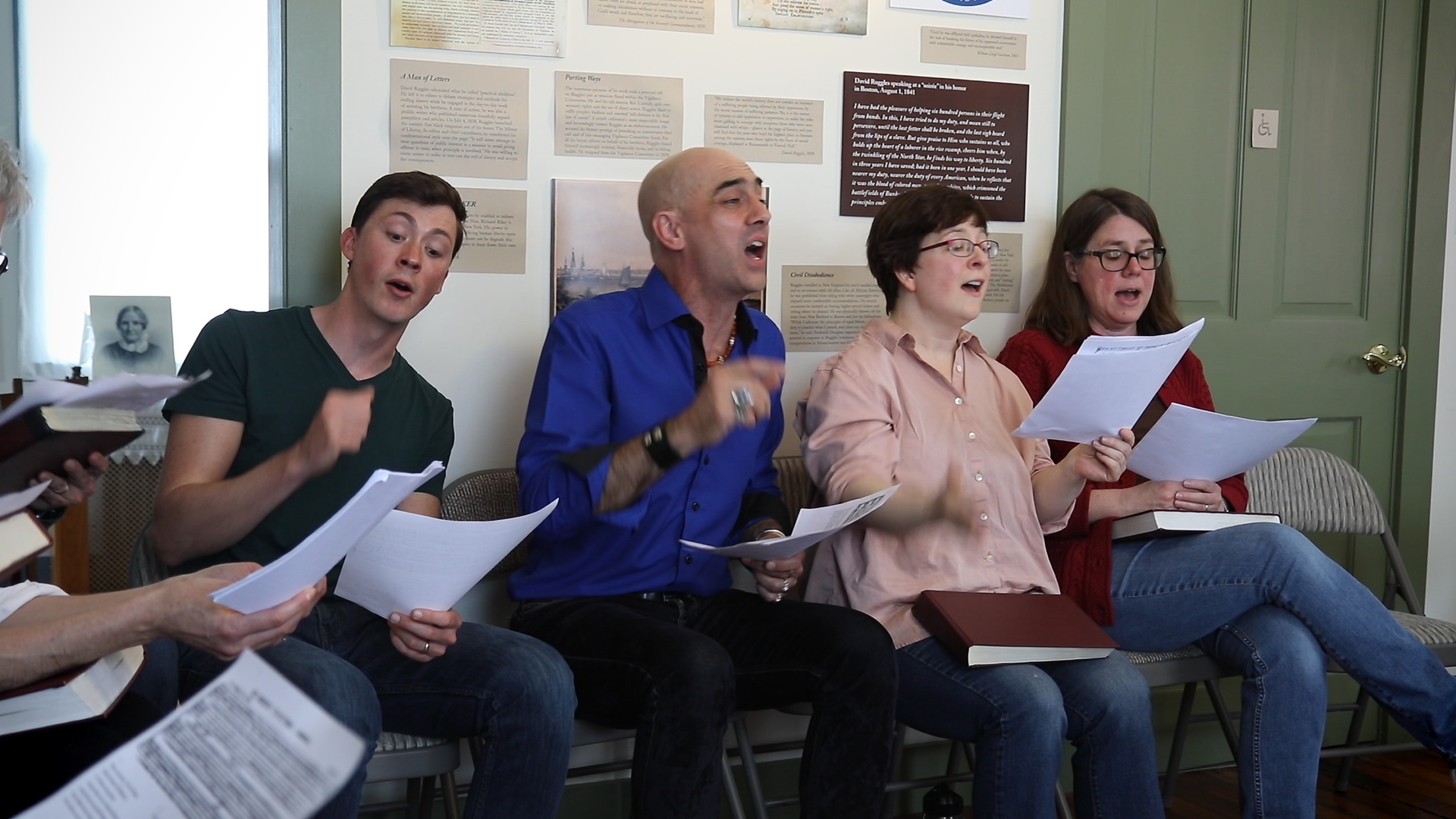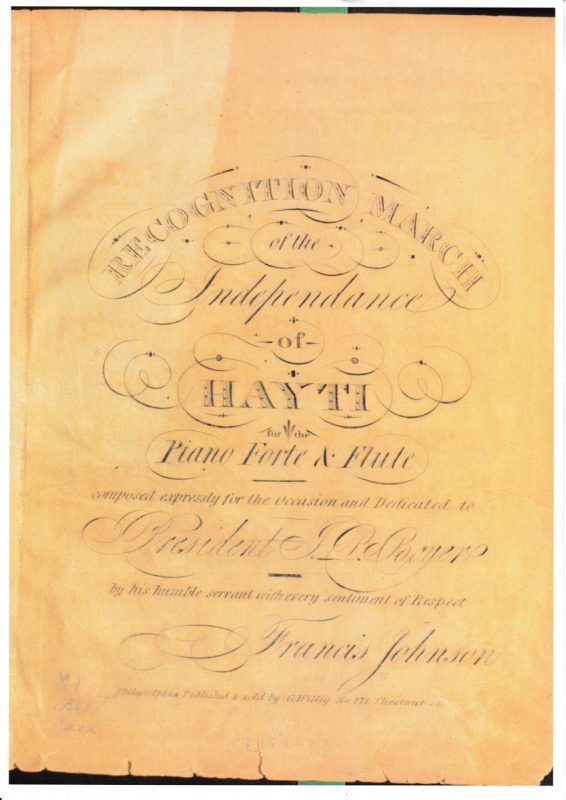
Books Editor Rick Bayles writes – Songs of ‘Slavery and Emancipation’ is the last project our sadly departed colleague, Gordon Sharpe, took on for review. His sudden and unexpected death meant that he never got to grips with this combination of Book, Film and CD that would’ve been right up his street and which we know he was really looking forward to tackling. Gordon’s wide literary knowledge, and his appreciation of integrated projects, would have had him pouring over this with a fine tooth comb and making connections to a wide range of reference material. Unfortunately, it was not to be. Gordon was a one off – which is probably why it has taken two of us to tackle what Gordon would happily have handled on his own. Paul Kerr and I have combined efforts to make sure Gordon’s last review is, finally, completed. We hope he would’ve approved.
“Songs of Slavery & Emancipation” – The Book
This is a very ambitious multi media programme, combining a book, a supporting CD and a documentary film but, given the scale of this project, the multi media approach is fully justified. In fact, given the importance of the project, a lesser approach would be doing the subject matter a disservice.
Let’s start with the book, because that is where this project really begins its life, with Mat Callahan’s outstanding writing on the ‘Songs of Slavery and Emancipation’. What marks this book out, for me, is the second part of that title. We’ve had books about slave songs before but these songs of emancipation offer a whole new dimension to explore and it brings something very special to this book. Slave songs are the base for the blues and you hear the suffering and torment in songs like ‘The Negro’s Complaint’
“To stand the lash and feel the pain,
Expos’d to stormy snow and rain.
To work all day and half the night,
And rise before the morning light!”
What this book goes to some length to establish is that, though enslaved, many in this situation were still able to focus on the future and the achievement of freedom. While many songs are about the suffering and the hardship these people were forced to face there was still a strength of spirit and a positivity about their situation. Compare the above lyrics to these from ‘Come Join the Abolitionists’
“Come join the Abolitionists, ye sons and daughters all;
Of this our own America, come at the friendly call.
O that will be joyful, joyful, joyful. O that will be joyful,
When all shall proudly say, This, this is Freedom’s day,
Oppression flee away! ‘Tis then we’ll sing and offerings bring,
When Freedom wins the day.”

Going out of his way to find the songs that call for rebellion and joining abolitionist groups, Mat Callahan is able to bring a much more empowering perspective on the subject of enslaved peoples. It makes sense that the early histories that were written about slavery were going to focus on the suffering and downtrodden nature of those that were the victims of this dreadful practice, but it’s heartening to realise that, for many, their spirit may have been downtrodden but it wasn’t broken. There’s a positivity to this book that elevates it above similar writings on this subject. To see songs inciting people to resist slavery and to actively fight against it, some of them coming from the very early days of slavery in the Americas, makes you realise that this was not an entirely one sided matter and that the slavers were not always in complete control of the people they subjugated.
 The book is quite academic in its tone but that’s in keeping with what is, in reality, a history book. Callahan isn’t simply recounting the existence of these different songs but putting them in the context of what is happening at the time. Callahan was inspired by a booklet he found in a San Francisco antiquarian bookshop, “Negro Slave Revolts in the United States, 1526 – 1860”. In the booklet the author, Herbert Aptheker, talks about many and frequent revolts throughout the history of slavery in the U.S and far more than had been previously documented. He also wrote about a song linked to an insurrection in 1813 that rang with the voice of insurgency
The book is quite academic in its tone but that’s in keeping with what is, in reality, a history book. Callahan isn’t simply recounting the existence of these different songs but putting them in the context of what is happening at the time. Callahan was inspired by a booklet he found in a San Francisco antiquarian bookshop, “Negro Slave Revolts in the United States, 1526 – 1860”. In the booklet the author, Herbert Aptheker, talks about many and frequent revolts throughout the history of slavery in the U.S and far more than had been previously documented. He also wrote about a song linked to an insurrection in 1813 that rang with the voice of insurgency
“Blow the clarion’s warlike blast: call every Negro from his task;
Wrest the scourge from Buckra’s hand, and drive each tyrant from the land”.
Powerful words that are recorded as having been sung by enslaved people at meetings to actively oppose slavery. As a communist, Aptheker had fallen foul of the McCarthy administration and his work was largely discounted in academic circles as a result. Callahan was resolved to pursue the possibility of a range of songs that, in addition to being about the life endured under slavery were also about active opposition to that same slavery. He wanted to go further than Aptheker and find more than the single example of an emancipation song that Aptheker describes in detail; he wanted to find songs linked to the many insurrections that Aptheker listed and show that they were a driving force in bringing slavery down. That he succeeded in his search is proven by the existence of this book and to go into too much detail would detract from the fascinating story he tells, but this is a book of considerable importance, I would say, in setting the significance of these songs in their historical context and adding a new chapter to the history of slavery in America. Callahan has assembled a collection of the lyrics to fifteen slave songs and fifteen songs of active opposition to slavery and calls for its abolition. The majority of these are songs that have not been heard since the early days of their composition. Most significantly, this book returns a part of Black American history that would seem to have previously been hidden from sight.
The contents of this book are, quite simply, fascinating and any reader with an interest in the history of slavery, the history of the U.S and the history of American music should have this down as one for their wish list but it’s a book that will have a wider appeal than just to those directly interested in the subject matter, because it also represents some outstanding research and a fascinating story about how these songs were brought together and what they mean for society as a whole.
As Kali Akuno, the Executive Director of Cooperation Jackson (a grassroots economic organisation in the city of Jackson, Mississippi), says in his Afterword for the book, “’Songs of Slavery and Emancipation’ carries crucial history that enlivens our collective memory and helps keep the spirit of resistance strong and moving forward.” This book is a remarkable achievement by Mat Callahan and all those that helped him in his quest to bring these songs together.
“Songs of Slavery and Emancipation” – The Film.
This accompanying film to this amazing project was produced by non-profit organisation, Art in History and Politics, in association with the National Abolition Hall of Fame and The Gerrit Smith Estate along with Berea College and it’s available for public viewing at https://www.arthistorypolitics.com/
Films of this nature are hard to get right and the producers should be congratulated on taking a difficult subject and bringing it to life on the screen. Documentaries dealing with historical content can often be dry and many producers of similar films take the historical reconstruction route to bring life to the subject – but that requires a big budget, not an option usually available to not for profit filmmakers. Instead, they’ve chosen to build the film around the recording of the CD, so we get some great footage of various combinations of people singing these songs identified in the book, interspersed with various talking heads and the occasional use of historic documents and pictures. The singing is, quite simply, glorious. My first reaction was to find the singing quite formal but these are songs that would have been sung either at spiritual gatherings or at formal comings together and you quickly realise that the style is absolutely right. It’s also very inspirational. You can hear the gospel influence in many of these songs but you also hear the rebellion and the resolve to bring about change. It’s nerve-tingling stuff and all the more powerful for being able to see peoples’ faces as they sing these songs. While they’re not singing them under the circumstances they were originally intended for, you can still see how inspiring they are and how much impact the content of the songs has on the singers.

Mixed in with the singing and recording sessions we have a series of talking heads, some of which work better than others. The key person to hear from, obviously, is the book’s author and the creator of this whole project, Mat Callahan. He presents himself well and talks through some of the major findings in his research and what he thinks is the significance of these songs. He’s very engaging and it’s good to hear him talking in this way. Much like spoken word novels, there’s an authenticity in hearing an author speak about his work that takes it up a level from simply reading the written word on the page. Other outstanding interviewees for this documentary include Dr. Kathy Bullock, the Chair of the Music Department at Berea College, who helped to assemble the singers for these recordings and talks about how she assembled the various combinations, and Dr. Timothy Eriksen, a historical ethnomusicologist (who was the soundtrack consultant for the Anthony Minghella movie, ‘Cold Mountain’) who provides some fascinating historical background to the songs of the abolitionist movement.
All in all, what could have been a dry and rather sedate academic film proves to be a very watchable accompaniment to the book and really helps to bring this music alive. Running at just under 50 minutes in length it’s long enough to put across its salient points without tipping over into unnecessary rambling.
All in all, this project is a triumph and a fascinating look into a piece of history that would appear to have been hidden from the wider world, until now. Kudos to all who have been involved with this move to shed light on these hidden gems and bring these songs of slavery and emancipation to a wider audience.
“Songs Of Slavery And Emancipation” (The CDs)
An aural accompaniment to the book, this two-disc collection (available separately) brings to life many of the songs discovered by and detailed within its pages by Matt Callahan. Disc one features songs which were popular among slave communities while disc two is composed of songs written and sung by abolitionist groups, an early version of protest songs.
It might be commonplace to consider that Africans, forcibly transported across the Atlantic, were stripped of most things, including their dignity, but that they held on to their musical culture – it’s an abiding idea which posits that this culture, the drums and string instruments, the chants and laments, all fed into the well of what became American roots music. The collection doesn’t dispute this but, in the introductory notes, it warns that “We’ve all been taught that the slaves sang, and sang well, courtesy of racist stereotypes of Africans as naturally musical people… American popular culture peddled images of Black bodies dancing and singing in cotton fields…” They argue that this popular image actually erased much of the genuine repertoire of those times with only the most popular spirituals surviving. Hence, the notes advise, “You won’t find your standard work ditties or classic spirituals here.” Indeed, of the 31 songs here, only one (‘The Year Of Jubilo’) is familiar to this reviewer (and that’s down to a version of it by a male white folk duo).
The songs were selected by Callahan, initially inspired by a second-hand book find which included a song composed by slaves planning an insurrection in 1813. His research looked for songs which were defiant, angry, as opposed to supplicant pleas to a God who seemed to have abandoned them. Instead, they celebrate slaves such as Nat Turner who led a rebellion and denounce the 1857 Supreme Court ruling that slaves did not have the constitutional rights afforded to white Americans, a decision which fired up John Brown’s fury and which led, eventually, to the civil war. In an attempt at authenticity (in the main achieved) Callahan looked for the “best arrangements” he could find which survive for these songs from a century and a half before and recorded them using one mic whether the performance was solo or from a group of singers. More than 50 musicians were involved and the recordings took place in various locations.

As such, the songs are generally quite formal in delivery, the choir performances cleaving to the then popular “shape-note” style. There’s little of the passion one finds emanating from an album such as ‘Songs Of Our Native Daughters’, instead, it seems that the main purpose of the discs is to illuminate the findings contained within the book and to serve notice that these songs once existed and (thanks to this project) live again. For the listener, it’s an opportunity to become aware of this forgotten seam of protest and rebellion with the album a fascinating listen which can be safely enjoyed without the assistance of the book, the copious liner notes acting like a cliff notes summary.
While the second disc of abolitionist songs is mainly choral, disc one, the songs sung by slaves, has more variety and, for want of a better term, is more enjoyable. It’s certainly more descriptive of the injustices meted out. The description of a lynching in ‘The Dirge Of St. Malo’, sung first in Louisiana Creole and then in English is quite chilling while the disc opens with Alden Smith’s compelling acapella rendition of ‘Agonizing Cruel Slavery Days’, sung as an elderly man looking back on his days in bondage. String band arrangements enliven songs such as ‘Uncle Gabriel The Negro General’, ‘Old Massa He Come Dancin’ Out’ and the aforementioned ‘The Year Of Jubalo’ while the arrangement of ‘We’ll Soon Be Free/My Father How Long’ reminds one of recent artists such as Sweet Honey In The Rock. ‘To The White People Of America’, an abolitionist song from 1854 and performed here by Eli Smith is a precursor of Woody Guthrie and eventually Dylan, two white men who, in their early years at least, would have shared the sentiment.

Songs about slave rebellions in Haiti and Curaçao show that American slaves were aware of uprisings elsewhere and there is a glimpse of hope in some of the abolitionist songs such as ‘The Underground Railroad’ (found by Callahan in an 1854 publication) while a fine sense of irony is to found on reading that ‘Song Of The “Aliened American”‘, the opening song on disc two, is sung to the tune of ‘America – My Country ‘Tis Of Thee’ which was itself derived from ‘God Save The King’. A reminder that the UK was as complicit as America in benefiting from the slave trade. The sheer cruelty is fully exposed on Hannah From’s haunting acapella delivery of ‘Stole And Sold From Africa’, a song written by Addie Graham, an Appalachian singer born in 1890 and who lived until 1978. The thought that those slavery days are only a few generations away is cause for reflection.
As a stand-alone package, the CD of Songs Of Slavery And Emancipation deserves to be heard and should certainly be included in any serious study of the slave trade. It’s also recommended for those here who want to delve into the roots of the music we share a love for.
The Book and CD are now both available through all the usual outlets as well as the website but we are advised that shipping costs for Europe are cheaper via the Eurospan online bookstore.


